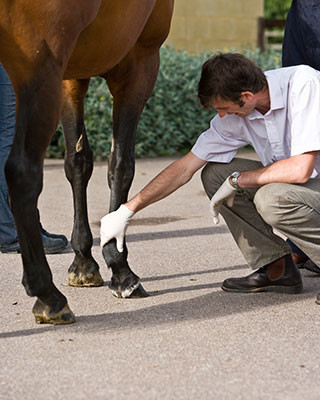Lameness Assessments
Lameness Assessments and Poor Performance Investigations
Oakham Veterinary Hospital is a leading centre for lameness assessment, seeing many of both our own patients and referral cases. It is an area of special expertise and interest for several of our senior clinicians. The hospital assesses horses from a wide range of disciplines, from the hairiest of ponies to top event horses that are competing around the globe.
We have two large trot up areas where the vets can assess horses moving at walk and trot, both in hand and on the lunge. We also have a 20x40 arena that is available to assess horses both under saddle and on the lunge, as some subtle lameness' can appear different on a soft surface. Horses may be ridden both by their owners and occasionally, by one of our team (with the owner's permission).
The usual starting place for diagnosing a lameness would be nerve blocks. This involves injecting a local analgesic around a nerve, or directly into a joint or synovial structure, which temporarily removes the sensitivity in that area. Once the block has time to take effect, the horse is then re-assessed to see if the lamness has improved. Once the area causing the lameness has been identified, diagnostic imaging is then used to visualise the problem. The type of imaging used will depend on the nature of the lameness but may include radiography, ultrasonography, MRI or scintigraphy.
analgesic around a nerve, or directly into a joint or synovial structure, which temporarily removes the sensitivity in that area. Once the block has time to take effect, the horse is then re-assessed to see if the lamness has improved. Once the area causing the lameness has been identified, diagnostic imaging is then used to visualise the problem. The type of imaging used will depend on the nature of the lameness but may include radiography, ultrasonography, MRI or scintigraphy.
Poor performance analysis can be a complex issue, and often requires several areas of expertise. There are many possible causes which is why work ups can often take several days. Causes of poor performance can range from medicinal, (anaemia, gastric ulcers), to reproductive, (particularly in mares), and can also include rider/training issues.
Once the cause of lameness/poor performance has been established, we will be able to guide you on the appropriate treatment and management options. These can include anything from treatments such as IRAP®, stem cells, PRP, shockwave therapy, surgery to farriery and exercise programmes.
Pre Purchase Examinations
The process of vetting a horse is a 5 stage procedure as dictated by the Royal College of Veterinary Surgeons, with the aim of standardising the examination. These examinations are undertaken to reduce buyer risk through assessing a horse’s current and likely future soundness by identifying pre-existing conditions, current health status, and fitness for intended use. The veterinarians at Oakham conduct many vettings in a year, normally taking about 90 minutes, and consisting of a series of thorough checks both in hand and under saddle. Vettings can be carried out at the hospital or at the vendor's premises.
There are five stages to the process which are as follows:-
- The first stage is observation of the horse at rest. The vet will note breathing rate, examine the eyes in a dark area using an opthalmoscope and listen to his heart. The horse is then given a full surface examination of the skin, limbs and teeth in good light. The inspection of teeth is simply to confirm age – a full dental examination will only be conducted at your specific request.
- The second stage should be carried out on a hard surface, and involves walking and trotting the horse in a straight line, looking for signs of lameness, and then conducting flexion tests on the joints of the lower limbs. If these tests are passed, the horse will be reined back and trotted on a circle on each rein – this will exacerbate any subtle lameness problems.
- Stage three requires strenuous exercise, preferably ridden or lunged. If the horse in unbroken it must be loose schooled. The vet will then listen for abnormal heart and wind sounds, and also assess the gait at walk, trot and canter.
- The fourth stage is a period of rest for 20 - 30 minutes, to elicit any stiffness when the horse is re-examined at stage five.
- The last stage involves trotting the horse up, listening to the heart, and looking further at any areas of concern. A blood sample will also be taken and stored.
Once these stages have been completed many horses go on to have extra examinations as per the request of the owner. These can include xrays, ultrasound, scanning of the legs, endoscopy or gastroscopy.
Our vets are happy to carry out pre purchase examinations for both our own clients, and for clients from further afield. In some circumstances our vets will, if requested by the purchaser, perform a limited (two-stage) examination. However the potential purchaser must be aware that the examination will be limited in its scope and may not detect important clinical factors that could influence their decision to purchase the horse. For this reason a disclaimer must be signed before a 2-stage vetting for purchase is undertaken.
Insurance examinations can also be carried out for an existing owner of a horse, and will usually follow the same format as the five-stage, PPE but will not include an opinion and should not be interpreted as a pre-purchase examination.